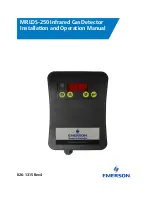
Mounting Procedure
Mounting the Gas Detector • 7
The size and nature of the site can help in deciding
which method is the most appropriate to use.
Locations requiring the most protection in a
machinery or plant room would be in close proximity
to compressors, pressurized storage vessels,
refrigerant cylinders, storage rooms, or pipelines. The
most common leak sources are valves, gauges,
flanges, joints (brazed or mechanical), and filling or
draining connections.
•In machinery rooms where there is little or no
airflow, placement options are:
•Point Detection: where gas detectors are located
as near as possible to the most likely sources of
leakage, such as the compressor, expansion
valves, mechanical joints, or cable duct trenches.
•Perimeter Detection: where gas detectors com-
pletely surround the area or equipment.
•Halocarbon and hydrocarbon refrigerants are
heavier-than-air gases and as such, the gas detectors
should be located near ground level (6 to 18 inches
from the floor).
NOTE: Gas detectors should be
positioned just far enough back
from any high-pressure parts to
allow gas clouds to form and be
detected. Otherwise, a gas leak
might pass by in a high-speed airflow area
and go undetected by the gas detector.
•Make sure that pits, stairwells, and
trenches are monitored since they may fill
with stagnant pockets of gas.
•For racks or chillers pre-fitted with
refrigerant gas detectors, these should be
mounted so as to monitor the compressors.
•Do not mount the gas detector directly to
pipes or structures that are subject to
strong vibration.
2.2.3.
Refrigerated Spaces
In refrigerated spaces, gas detectors should be located
away from doors, in the return airflow to the
evaporators on a sidewall (below head-high is
preferred), or on the ceiling, not directly in front of an
evaporator, nor in any direct airflow. In large rooms
with multiple evaporators, gas detectors should be
mounted on the central line between two adjacent
evaporators, as turbulence will result in airflows
mixing.
2.2.4.
Chillers
In the case of small water- or air-cooled enclosed
chiller units, mount the gas detector to monitor airflow
to the extract fans. With larger models also place a gas
detector inside the enclosure under or adjacent to the
compressors.
For enclosed air-cooled chillers or the outdoor unit for
variable refrigerant volume and variable refrigerant
flow (VRV/VRF) systems, mount the gas detector to
monitor airflow to the extract fan. With large units
also place a gas detector inside the enclosure under or
adjacent to the compressors.
2.3.
Mounting Procedure
To open the housing as received, use a flat blade
screwdriver and depress the top latch. While pushing
the latch, grasp the back edge of the housing near the
latch and pull the back away.
When mounted, the housing is simply opened by
pressing the top latch with a suitable screwdriver or
other flat blade. With the top latch depressed, pull the
housing apart by grasping the sides and pulling
straight out. With the housing separated, the mounting
base with terminal blocks will be visible.
See
Figure 2-1
.
CAUTION: Do not apply caulking
or other material around the gas
detector base. The gas detector
relies on air exchange through the
spaces between the base and the
gas detector housing. Do not obstruct the
small gap around the housing and the base
with any material.














































